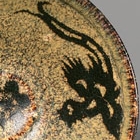J.J. Lally & Co., Oriental Art / New York City, New York
MenuPast Exhibition
SONG DYNASTY CERAMICS:
The Ronald W. Longsdorf Collection
March 15 - April 13, 2013
33.
A JIZHOU PAPER-CUT DECORATED PHOENIX AND FLOWERS TEA BOWL
Song Dynasty (A.D. 960-1279)
with gently rounded flaring sides rising to a shallow ‘finger groove’ below the lipped rim, decorated with a stenciled design of a pair of long-tailed phoenix and two stylized flowerheads on the interior sides, and with a third flowerhead in the central medallion forming the floor of the bowl, the decoration all reserved in very dark brown on a variegated tan and reddish-brown glazed background, the exterior with splashed and streaked tan-colored ‘tortoiseshell’ markings on a dark brown background, the ring foot of wedge-shaped section enclosing a countersunk base left unglazed, showing the buff pottery body.
Diameter 4 3⁄4 inches (12 cm)
A Jizhou paper-cut decorated tea bowl of this form decorated with the same design in the collection of the Palace Museum, Beijing is illustrated in Gugong bowuyuan cang wenwu zhenpin quanji (33) Liang song ciqi, xia (The Complete Collection of Treasures of the Palace Museum, Vol. 33, Porcelain of the Song Dynasty II), Hong Kong, 1996, p. 239, no. 219.
A very similar tea bowl in the collection of the Jiangxi Provincial Museum is illustrated by Peng in Ya su zhi jian: Jizhou yao (Jizhou Kiln), Beijing, 2007, no. 43; another similar example is illustrated in Black Porcelain from the Mr. and Mrs. Yeung Wing Tak Collection, Guangzhou, 1997, pp. 190-191, no. 93; and another Jizhou tea bowl of closely related design from the collection of H.O. Havemeyer is illustrated in The World’s Great Collections, Oriental Ceramics, Vol. 11, The Metropolitan Museum of Art, New York, Tokyo, 1982, fig. 56.
Compare also the similarly decorated Jizhou tea bowl of this form in the collection of The Harvard University Museums, illustrated by Mowry in Hare’s Fur, Tortoiseshell, and Partridge Feathers: Chinese Brown- and Black-Glazed Ceramics, 400-1400, Cambridge, 1996, pp. 240-241, where the author presents a detailed discussion of the paper-cut decoration technique and the use of stencils for decoration of ceramics at Jizhou and other Song dynasty kilns.
宋 吉州剪紙貼花雙鳳梅紋盞 徑 12 厘米
